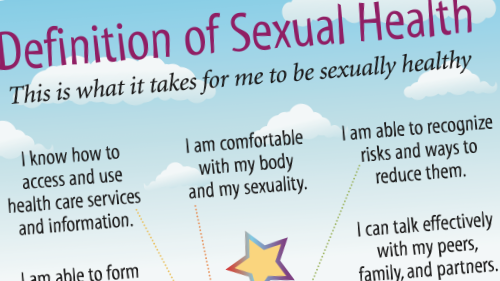Youth Statistics: Sexual Health
Sexual Orientation Overview
Sexual attraction, behavior, and identity are not always aligned: a person primarily attracted to women may also have sexual contact with men and may or may not identify as gay, bisexual, or straight. Sexual identities, attractions, and behaviors may all change over time. This fluidity may be true of both adolescents and adults, and is reported more frequently by youth and by sexual and gender minorities [1].
A large, anonymous survey of U.S. high school students (Youth Risk Behavior Survey) found that in 2023 [2]:
- 73% of students identified with the term "heterosexual (straight)."
- 4% identified as "gay or lesbian."
- 11% identified as "bisexual."
- 4% indicated they were not sure of their sexual identity.
- 4% responded "I describe my sexual identity some other way."
- 3% indicated they did not understand the question.
Most lesbian, gay, bisexual, and/or transgender students experience harassment at school [3]. In a 2021 survey, 76% of LGBTQ+ middle and high school students reported verbal harassment, 31% physical harassment, and 12.5% physical assault [4]. The majority of students who were harassed or assaulted did not let school staff know what had happened [4]. Over half (58%) had heard homophobic remarks from teachers or other school staff [4]. Boys who are perceived to be gay are especially likely to face bullying [3]. The presence of Gay-Straight Alliance / Gender Sexuality Alliance (GSA) clubs within a school setting has been demonstrated to foster a safer environment, but most LGBTQ+ students reported that their school did not have a GSA [4].
Romantic Relationships and Sexual Experience
Sexual curiosity begins in early childhood [5]. Young children may also experience deep feelings of love for another child [5]. When puberty begins, interest in both sex and romantic connection may intensify, around age 10-13 [5, 6]. Crushes and idol worship are common in early adolescence and may help young people gradually become emotionally ready for romantic relationships and consensual experiences [5]. Dating often begins in high school, though there is tremendous variability in timing of dating, initiation and number of romantic relationships, and how long relationships last [7].
Sexual Behaviors
Generally speaking, sexual exploration is common in adolescence. About half (54%) of adolescents age 15-19 have had some type of sexual experience [8]. However, adolescents are having less sex today than they were a decade ago. An analysis of the 2009 and 2018 waves of the National Survey of Sexual Health and Relationships found that solo masturbation, partnered masturbation, oral sex, and anal and vaginal intercourse all decreased among adolescents age 14-17 [9]. Analysis of the NSFG confirms a decline in most sexual behaviors among teens (with the exception of same-sex partnered behaviors) [8].
Masturbation
Some children masturbate in early childhood, and by age 10 the behavior is common, though incidence has decreased in recent years [5, 9]. One nationally representative study found that in 2018, 40% of teens age 14-17 reported masturbating within the last year; in 2009 the number was 56% [9].
Vaginal Intercourse / "Sexual Intercourse"
An analysis of the 2015-2019 NSFG found that by age 19, about 70% of youth have had penile-vaginal intercourse [8]. Rates of vaginal intercourse have declined for both females and males since 1988 [10]. In the 2023 Youth Risk Behavior Surveillance survey, 32% of high school students reported having had "sexual intercourse" at some point in their lives [2]. Over one in four students were currently sexually active (had sexual intercourse at least once in the three months before taking the survey), a decrease in the last 10 years [2]. Note that "sexual intercourse" was not defined in the survey. Asian high school students are less likely to have had intercourse (14%) or be currently sexually active (11%) than are students who are American Indian/Alaska Native, Black, Latinx, multiple race, Native Hawaiian/Other Pacific Islander, or White [2].
Most people who identify as lesbian, gay, or bisexual (79% women and 55% men) have had penile-vaginal sex, typically earlier than their first same-sex experience [11].
About one in three adolescents has had penile-vaginal intercourse by age 16 [8].
On average, rural women experience heterosexual vaginal sex earlier than urban women [12].
Heterosexual Oral Sex and Anal Sex
- Among young people age 15-19, about 44% have had oral sex with a different-sex partner [8].
- Just under one in ten teens age 15-19 has had anal sex with a different-sex partner [8].
Same-Sex Experiences
- Among young women age 15-19, 15% have had a sexual experience with a same sex partner (11% age 15-17 and 19% age 18-19) [8].
- Among young men age 15-19, 3% have had a sexual experience with a same-sex partner [8].
For people identifying as lesbian or gay, the mean age of first sexual experience with a same-sex partner is nearly 19 [11]. For bisexual women, first same-sex experience typically occurs later at age 20; for bisexual men, the mean age is slightly earlier at 18 [11].
Condoms and Contraceptives
Among sexually active high school students, condom use at most recent sexual intercourse has declined from the recent high of 63% in 2003 to 52% in 2023 [2]. One study of teen males who have sex with women identified a decline in condom use specifically among males with additional STI risk factors [13].
Most teens use a condom or other form of contraception the first time they have sexual intercourse (78% of sexually experienced females, 89% of males) [10].
According to the 2015-2017 NSFG, the most popular form of birth control among teen women age 15-19 is the condom (used at least once by 97% of sexually experienced females), followed by withdrawal (65%) and the pill (53%). Young women also indicated having at some point used the following contraceptive drugs or devices: injectables such as Depo-Provera (used by 19% of sexually experienced women age 15-19), fertility awareness methods (11%), emergency contraception (19%), the contraceptive patch (1%), and long-acting reversible contraception (20%) [10]. Current use of long-acting reversible contraceptives (IUDs and implants, also known as LARCs) remains low at 6% of contraceptive-using women age 15-19 [14].
Access to Services
Among teen women age 15-17, 31% receive contraceptive services [15]. The proportion of teens receiving services has been stable, but the source has changed: While two out of five teens seeking contraceptive services used publicly funded clinics in the period 2006-2010, only about one in four used clinics in 2015-2019 [15]. Instead, teens are increasing relying on private physicians, reflecting either an increase in private insurance coverage or a greater willingness to use private insurance [15].
Risky Behaviors
Sexual exploration is a natural part of adolescent development. Certain behaviors, however, do increase risk of acquiring sexually transmitted infections (STIs) and/or pregnancy.
For statistics on dating violence, see Youth Statistics: Health.
Multiple Sex Partners
Among high school students, 7% of males and 5% of females report having four or more sexual partners in their lifetime, a decrease from 2013 [2].
Condomless Sex and Condom Breakage/Slippage
Defective condoms are rare, but condoms do fail when users don't fully understand how to handle them correctly. Although it carries an especially high level of risk for HIV and STIs, anal sex among adolescents is often unprotected [16, 17] as is (lower risk) oral sex [16, 18].
One study of condom-using high school students found [19]:
- 71% did not squeeze the tip of the condom.
- 25% did not roll the condom all the way down the penis.
- 49% did not hold the condom at the base of the penis when pulling out.
- 37% reported condom breakage or slippage.
Adolescent Pregnancy, Abortion, and Birth Rates
Unintended pregnancy rates for teens age 15-19 declined by 52% between 2010 and 2019 to a rate of about 21 unintended pregnancies per 1,000 females [20]. Compared to other age groups, teens and young adults (age 20-24) have made the most progress in avoiding unintended pregnancy [20]. An estimated 71% of pregnancies to 15-19 year olds are unintended [20]. In 2019, the overall (i.e., intended and unintended) pregnancy rate for the 15-19 year old age group was 29 pregnancies per 1,000 females [20]. Teens who identify as lesbian, gay, or bisexual have higher rates of pregnancy involvement than heterosexual teens [21].
From 2012-2021, the teen abortion rate declined 41% to a rate of 5.6 abortions per 1,000 women age 15-19 [22]. While most women (including teens) who have abortions do so in the first trimester of pregnancy, teens are overrepresented among women who have abortions at 13 weeks or later [22].
Birth rates among teens have fallen steeply since 1991, and are now at historic lows for all racial/ethnic groups [23]. Between 1991 and 2022, birth rates declined 78% among teens age 15-19 (to 13.6 births per 1,000) [23].
Across New York State, the 2021 pregnancy rate was 3.2 per 1,000 females under age 18 and 30.5 per 1,000 teens age 18-19 [24]. In New York State in 2021, there were 5,416 births to females under age 20 [25].
Sexually Transmitted Infections (STIs) and HIV
Over 2.5 million cases of chlamydia, gonorrhea, and syphilis were reported in the U.S. in 2022, half of these among young people (ages 15-24) [26]. The most common STI is human papillomavirus, which is contracted at some point by nearly every unvaccinated sexually active person [27]. There has been a surge of syphilis cases in all age groups, including a 17% increase from 2021 to 2022. In 2022, syphilis cases reached their highest level since 1950 [26].
Among young people age 13-24, new HIV infections declined 34% between 2017 and 2021 [28]. Gay and bisexual males were largely behind the trend, potentially through greater HIV testing, treatment, and use of pre-exposure prophylaxis (PrEP). While each group saw substantial declines, this progress was not equitable: young white men who have sex with men (MSM) saw the biggest declines (45%) while young Black and Latinx MSM saw declines of 27% and 36% respectively [28]. Despite declines, the majority of new HIV diagnoses continue to be among gay and bisexual men [28].
Endnotes
- Katz-Wise, S. L., & Todd, K. P. (2022). The current state of sexual fluidity research. Current Opinion in Psychology, 48, 101497. doi.org/10.1016/j.copsyc.2022.101497
- U.S. Department of Health and Human Services, Centers for Disease Control and Prevention. (2024, October 10). Youth Risk Behavior Surveillance - United States, 2023. MMWR Supplement, 70(4). For another way to access YRBS data, including state and regional results, see the interactive database YRBS Explorer:
- Moyano, N. & Sánchez-Fuentes, M. del M. (2020). Homophobic bullying at schools: A systematic review of research, prevalence, school-related predictors and consequences. Aggression and Violent Behavior, 53, 101441. doi.org/10.1016/j.avb.2020.101441
- Kosciw, J. G. & Clark, C. M. (2022). The 2021 National School Climate Survey: The experiences of LGBTQ+ youth in our nation's schools.
- Cacciatore, R., Korteniemi-Poikela, E., & Kaltiala, R. (2019). The Steps of Sexuality—A developmental, emotion-focused, child-centered model of sexual development and sexuality education from birth to adulthood. International Journal of Sexual Health, 31(3), 319-338. doi.org/10.1080/19317611.2019.1645783
- Connolly, J., Shulman, S., & Benvenuto, K. (2023). Romantic relationships in adolescence and early adulthood. In L. J. Crockett, G. Carlo, & J. E. Schulenberg (Eds.), APA Handbook of Adolescent and Young Adult Development. American Psychological Association.
- Gonzalez Avilés, T., Finn, C., & Neyer, F. J. (2021). Patterns of romantic relationship experiences and psychosocial adjustment from adolescence to young adulthood. Journal of Youth and Adolescence, 50(3), 550-562. doi.org/10.1007/s10964-020-01350-7
- Lindberg, L. D., Firestein, L., & Beavin, C. (2021). Trends in U.S. adolescent sexual behavior and contraceptive use, 2006-2019. Contraception: X, 3, 100064. doi.org/10.1016/j.conx.2021.100064
- Herbenick, D., Rosenberg, M., Golzarri-Arroyo, L., Fortenberry, J. D., & Fu, T. (2022). Changes in penile-vaginal intercourse frequency and sexual repertoire from 2009 to 2018: Findings from the National Survey of Sexual Health and Behavior. Archives of Sexual Behavior, 51(3), 1419-1433. doi.org/10.1007/s10508-021-02125-2
- Abma, J. C., & Martinez, G. M. (2020, May). Sexual activity and contraceptive use among teenagers aged 15-19 in the United States, 2015-2017. National Health Statistics Reports.
- Brewster, K. L., Tillman, K. H., & Holway, G. V. (2021). Timing of first sexual experience with a same-sex partner: A life course approach. Archives of Sexual Behavior, 50(8), 3587-3599. doi.org/10.1007/s10508-021-02043-3
- Janis, J. A., Ahrens, K. A., & Ziller, E. C. (2019). Female age at first sexual intercourse by rural-urban residence and birth cohort. Women's Health Issues, 29(6), 489-498. doi.org/10.1016/j.whi.2019.07.004
- Copen, C. E., Dittus, P. J., Leichliter, J. S., Kumar, S., & Aral, S. O. (2022). Diverging trends in US male-female condom use by STI risk factors: A nationally representative study. Sexually Transmitted Infections, 98(1), 50-52. doi.org/10.1136/sextrans-2020-054642
- Daniels, K., & Abma, J. C. (2020, October). Current contraceptive status among women aged 15-49: United States, 2017-2019. NCHS Data Brief No. 388.
- Frost, J. J., Mueller, J., & Pleasure, Z. H. (2021). Trends and Differentials in Receipt of Sexual and Reproductive Health Services in the United States: Services Received and Sources of Care, 2006-2019.
guttmacher.org/report/sexual-reproductive-health-services-in-us-sources-care-2006-2019
- Habel, M. A., Leichliter, J. S., Dittus, P. J., Spicknall, I. H., & Aral, S. O. (2018). Heterosexual anal and oral sex in adolescents and adults in the United States, 2011-2015. Sexually Transmitted Diseases, 45(12), 775-782. doi.org/10.1097/OLQ.0000000000000889
- Samuel, K. (2019, May 3). How does condom use change over time as young MSM get older?
aidsmap.com/news/may-2019/how-does-condom-use-change-over-time-young-msm-get-older
- Holway, G. V., & Hernandez, S. M. (2017). Oral sex and condom use in a U.S. national sample of adolescents and young adults. Journal of Adolescent Health. doi.org/10.1016/j.jadohealth.2017.08.022
- Barrett, M., Laris, B. A., Anderson, P., Baumler, E., Gerber, A., Kesler, K., & Coyle, K. (2021). Condom use and error experience among young adolescents: Implications for classroom instruction. Health Promotion Practice, 22(3), 313-317. doi.org/10.1177/1524839920935431
- Rossen, L. M., Hamilton, B. E., Abma, J. C., Gregory, E. C. W., Beresovsky, V., Resendez, A. V., et al. (2023). Updated methodology to estimate overall and unintended pregnancy rates in the United States. National Center for Health Statistics. Vital Health Statistics 2(201).
- Leonardi, M., Frecker, H., Scheim, A. I., & Kives, S. (2019). Reproductive health considerations in sexual and/or gender minority adolescents. Journal of Pediatric and Adolescent Gynecology, 32(1), 15-20. doi.org/10.1016/j.jpag.2018.09.010
- Kortsmit, K., Nguyen, A. T., Mandel, M. G., Hollier, L. M., Ramer, S., Rodenhizer, J., & Whiteman, M. K. (2023, November 24). Abortion surveillance—United States, 2021. MMWR Surveillance Summaries, 72(9), 1-29.
- Osterman, M. J. K., Hamilton, B. E., Martin, J. A., Driscoll, A. K., & Valenzuela, C. P. (2024, April 4). Births: Final data for 2022. National Vital Statistics Reports, 73(2).
- New York State Department of Health. (n.d.). Table 27: Total pregnancy rate by age and resident county, New York State - 2021. Vital Statistics of New York State 2021.
- New York State Department of Health. (n.d.). Table 6a: Live births by race/ethnicity, birthweight and mother's age, New York State - 2021.
- Centers for Disease Control and Prevention. (2024, January 30). National overview of STIs, 2022.
- Centers for Disease Control and Prevention. (2024, July 3). Human Papillomavirus (HPV).
- NCHHSTP Newsroom, Centers for Disease Control and Prevention. (2023, May 23). HIV Declines Among Young People and Drives Overall Decrease in New HIV Infections.
cdc.gov/nchhstp/newsroom/releases/2023/2021-hiv-incidence.html
Page last updated October 17, 2024




